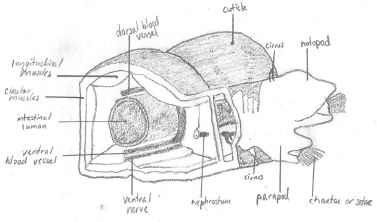Summary
Identification resources
Size
Ecology
Local distribution and Habitat
Crypsis
Life History & Behaviour
Defensive response
Reproduction
Locomotion
Feeding (Preference)
Anatomy & Physiology
External Morphology
Internal anatomy and physiology
Evolution & Systematics
Phylogenetics
Biogeographic Distribution
Distribution
Conservation & Threats
Threats
References & Links | Internal anatomy and Physiology
Circulatory system
E complanata exhibits a simple, yet effective, hemal circulatory system, common among the superclass Polychaete (Marcano et al, 1997). Circulation is achieved by fluid movement in the coelom and hemal system. Utilising two major blood vessels, blood is directed forwards in the dorsal vessel, returning down the body via the ventral blood vessel (Barnes, 1982; Ruppert et al, 2004; figure 1). Further blood distribution to the parapodia is regulated by a series of adjoining smaller blood vessels. Contractile blood vessels in this species aid in hemal circulation, in conjunction with the hearts.
Each body segment harbors a coelmic cavity, primarily concerned with the local distribution of nutrients. Coelmic fluid is distributed by internal cilia within the paired coelomic cavities of the individual segments, functioning for internal defense and local gas exchange (Marcano et al, 1997; Ruppert et al, 2004).

Figure 1. Internal anatomy of polychaete worms.
Respiratory system
Gas exchange in polychaetes often diffuses across the body wall (Ruppert et al, 2004). The presense of gills are often associated with the parapodia, with E complanata providing an excellent example of modified cirrus appendages (Ruppert et al, 2004; figure 1). The dorsal cirrus of the parapodium is modified as gills in this species. These are formed as bunched, threadlike gills radiate from the base of the notopodium (Ruppert et al, 2004; figure 2). Often found in intertidal habitats associated with low oxygen levels, the E. complanata may suppress it's metalbolism and function solely from stored oxygen, sourced from the bound hemoglobin (Ruppert et al, 2004).

Figure 2. The modified cirrus gills, attached to the base of the notopodium of E. complanata
Nervous system
Distinct cephalization in E. complanata has allowed development of a simple, yet effective, central nervous system. Adjoining the central ganglia, located in the prostomium, to the remainder of the body is a ventral nerve cord with a ganglion at each segment (Orrhage and Muller, 2005). Associated with a variety of visual and chemosensory appendages this system is vital to the ecology and behaviours of E. complanata. During fragmentation, the ventral nerve instigates new prostomium growth and eventual regeneration of the animal (Muller et al, 2003).
Digestive system
Little is known about E. complanata’s digestive system. Assuming digestive similarity with other polychaetes would indicate the fireworm has a flow through, regionalized gut. To efficiently derive nutrients the polychaetes gut is regionalized into three major components with differing functions, the foregut, midgut and the hindgut. Detail with other shitty fireworm webpage Musculature E complanata utilize both circular and longitudinal body wall muscles for their peristaltic movement (Pardo and Amaral, 2005; figure 1). The muscular pharaynx is a critical component of the fireworms eversible mouthparts; elaborated further in the Feeding behaviours section. |
|